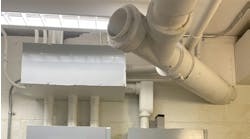How well do you know the Code? Think you can spot violations the original installer either ignored or couldn't identify? Here's your chance to moonlight as an electrical inspector and second-guess someone else's work from the safety of your living room or office. It's your turn to identify the violation.
Hint: Sky high
Find the Answer
The ice melting cable installed in the gutter of this dwelling unit remains plugged in year round. This means the receptacle cover where the ice melting cable is plugged in also remains open year round. This is a violation of 406.9(B), which requires 15A or 20A, 125V or 250V receptacles in a wet location to have a weather-proof enclosure — whether or not an attachment plug is plugged in or not.
The receptacle itself is required to be weather-resistant. The open cover exposes the receptacle to moisture, weather, and sunlight damage, which could create a fire or shock hazard. If this is a GFCI type receptacle, then 210.8 has also been violated. Because an extension ladder is needed to reach this location, the receptacle is mounted too high to be considered readily accessible, as required by this section of the Code.
Exception No. 1 of 210.8(B)(4) may permit GFPE protection instead of GFCI protection for the ice melt cables. However, this exception does not permit this type of cover, nor does it permit a non-weather-resistant type of receptacle.
One other thing, in accordance with 352.44, is an expansion fitting is needed on the PVC pipe, because its thermal expansion is greater than 0.25





